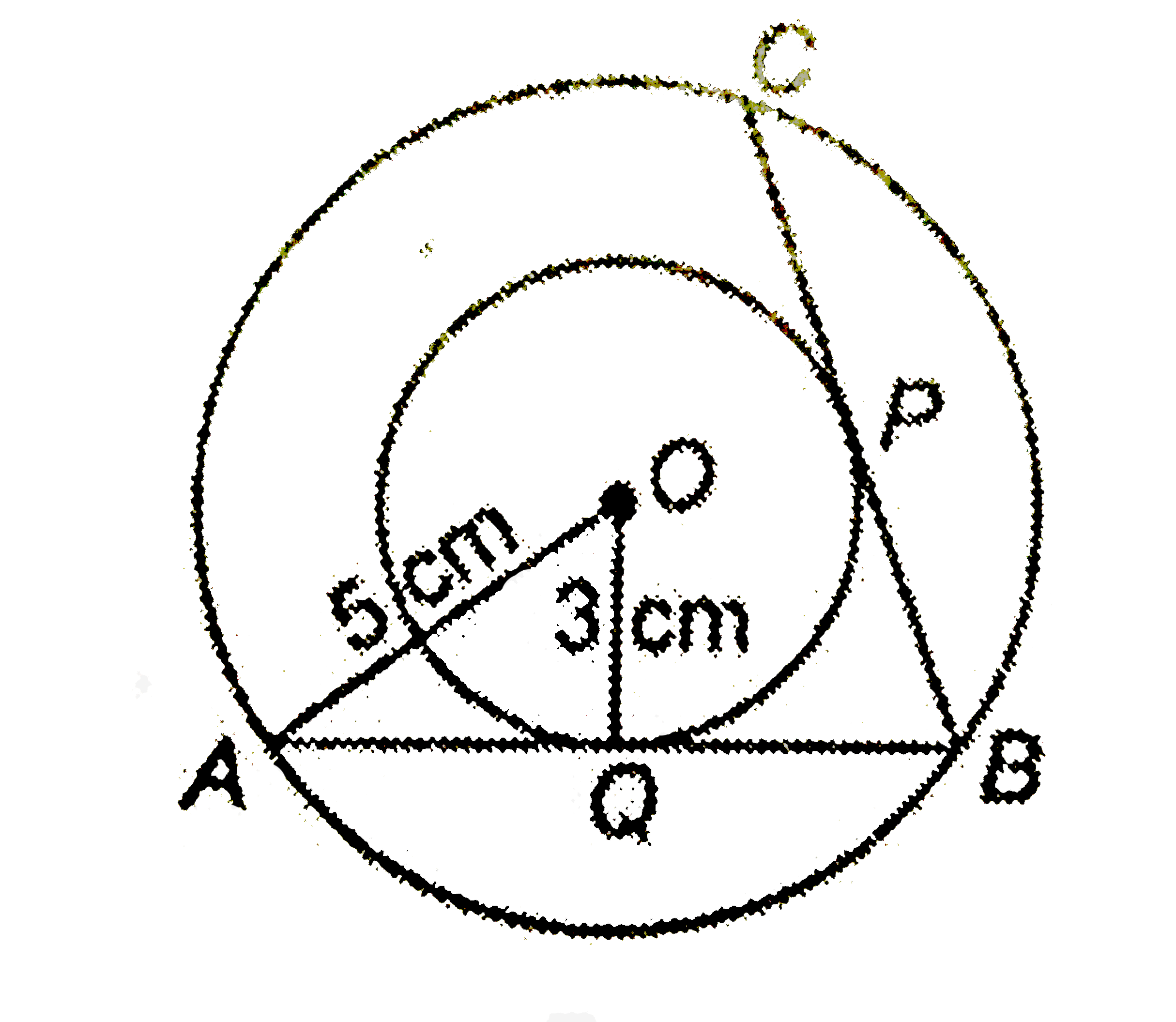Two concentric circles are of radii 5 cm and 3 cm. Find the length of the chord of the larger circle which touches the smaller circle.
To find the length of the chord of the larger circle that touches the smaller circle, we can follow these steps:
1. Identify the Radii:
- The radius of the larger circle (R) = 5 cm.
- The radius of the smaller circle (r) = 3 cm.
2. Understand the Geometry:
- Let the center of the circles be point O.
- Let the chord of the larger circle that touches the smaller circle be BD.
- Let the point where the chord touches the smaller circle be point C.
- The perpendicular from O to the chord BD will meet the chord at point B, and OC will be the radius of the smaller circle.
3. Draw the Right Triangle:
- In triangle OBC, we have:
- OB = radius of the larger circle = 5 cm (hypotenuse).
- OC = radius of the smaller circle = 3 cm (one leg of the triangle).
- BC = half the length of the chord BD (the other leg of the triangle).
4. Apply the Pythagorean Theorem:
- According to the Pythagorean theorem:
OB2=OC2+BC2
- Substituting the known values:
52=32+BC2
25=9+BC2
5. Solve for BC:
- Rearranging gives:
BC2=25−9=16
- Taking the square root:
BC=√16=4 cm
6. Find the Length of the Chord BD:
- Since BC is half of the chord BD, we have:
BD=BC+CD=4 cm+4 cm=8 cm
Final Answer:
The length of the chord BD of the larger circle which touches the smaller circle is 8 cm.
---
- The radius of the larger circle (R) = 5 cm.
- The radius of the smaller circle (r) = 3 cm.
- Let the center of the circles be point O.
- Let the chord of the larger circle that touches the smaller circle be BD.
- Let the point where the chord touches the smaller circle be point C.
- The perpendicular from O to the chord BD will meet the chord at point B, and OC will be the radius of the smaller circle.
- In triangle OBC, we have:
- OB = radius of the larger circle = 5 cm (hypotenuse).
- OC = radius of the smaller circle = 3 cm (one leg of the triangle).
- BC = half the length of the chord BD (the other leg of the triangle).
- According to the Pythagorean theorem:
OB2=OC2+BC2
- Substituting the known values:
52=32+BC2
25=9+BC2
- Rearranging gives:
BC2=25−9=16
- Taking the square root:
BC=√16=4 cm
- Since BC is half of the chord BD, we have:
BD=BC+CD=4 cm+4 cm=8 cm
The length of the chord BD of the larger circle which touches the smaller circle is 8 cm.
Similar Questions
Two concentric circles are of radii 5 cm. and 3 c. Find the length of the chord of the larger circle which touches the cmaller circle.
View SolutionTwo concentric circles are of radii 13 cm and 5 cm. Find the length of the chord of the larger circle which touches the inner circle.
View SolutionTwo concentric circles are of diameters 30cm and 18cm. Find the length of the chord of the larger circle which touches the smaller circle.
View SolutionIf the radii of two concentric circles are 4 cm and 5 cm, then find the length of each chord of one circle which is tangent to the other circle.
View SolutionTwo concentric circles of radii 3cmand5cm are given. Then length of chord BC which touches the inner circle at P is equal to (a) 4 cm (b) 6cm (c) 8 cm (d) 10 cm
View SolutionIf radii of two concentric circles are 4 cm and 5 cm, then length of each chord of one circle which is tangent to the other circle, is
View SolutionTwo concentric circle of radii 3cm and 5cm are given. Find the chord BC which touches the inner circle at P.

View SolutionIf radii of the two concentric circles are 15cm and 17cm, then the length of each chord of one circle which is tangent to other is: 8cm (b) 16cm (c) 30cm (d) 17cm
View SolutionIf radii of the two concentric circles are 15cm and 17cm, then the length of each chord of one circle which is tangent to other is: 8cm (b) 16cm (c) 30cm (d) 17cm
View SolutionProve that in two concentric circles, the chord of the larger circle, which touches the smaller circle, is bisected at the point of contact.
View Solution